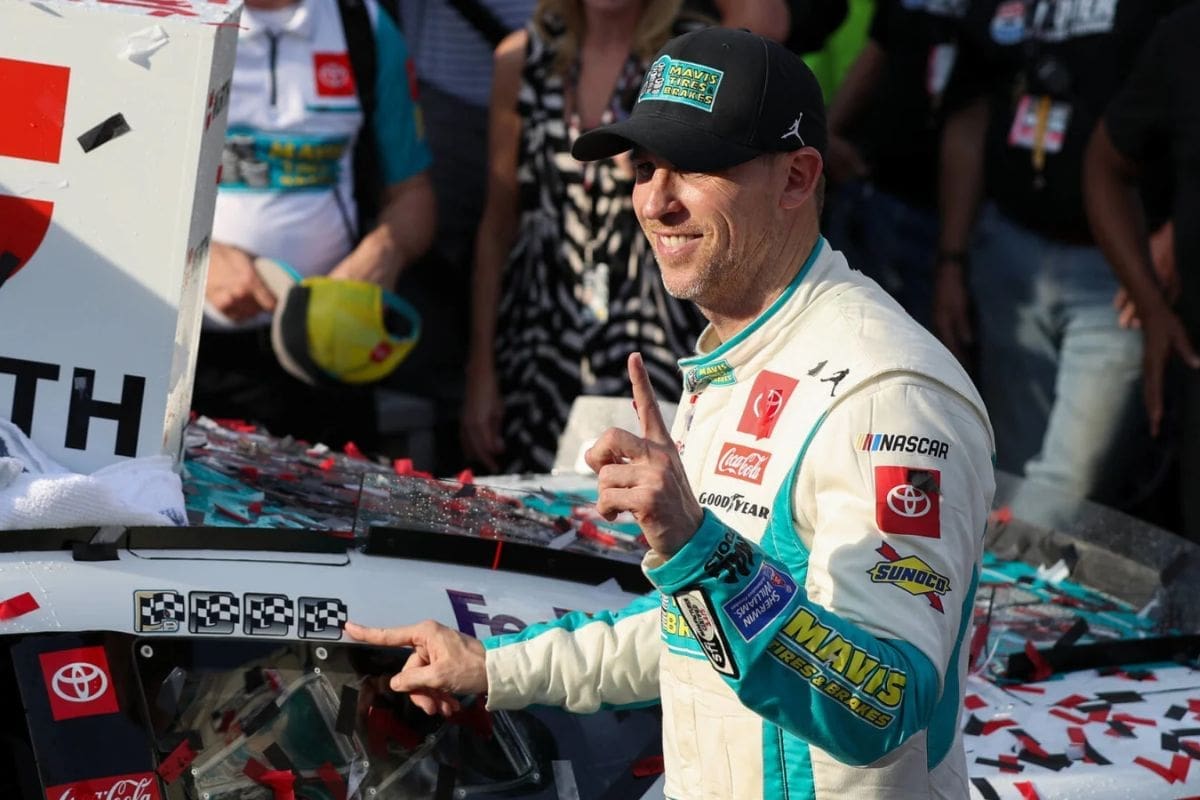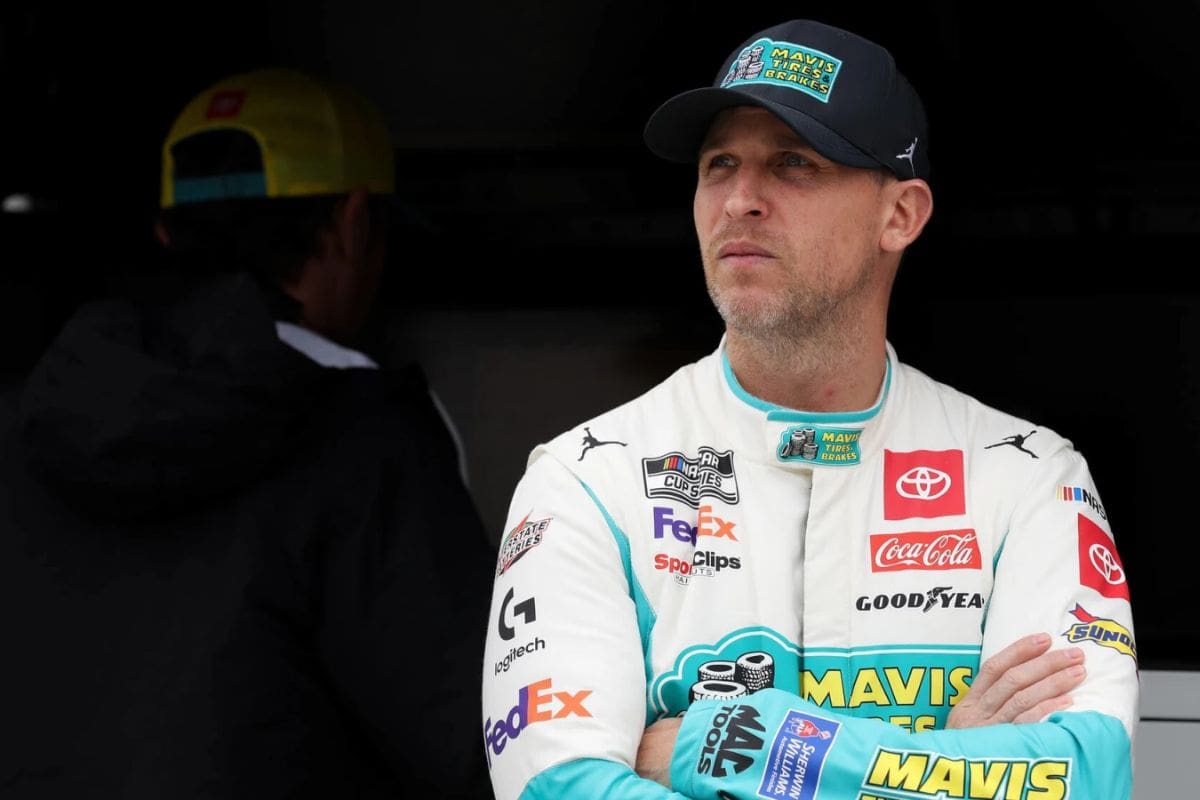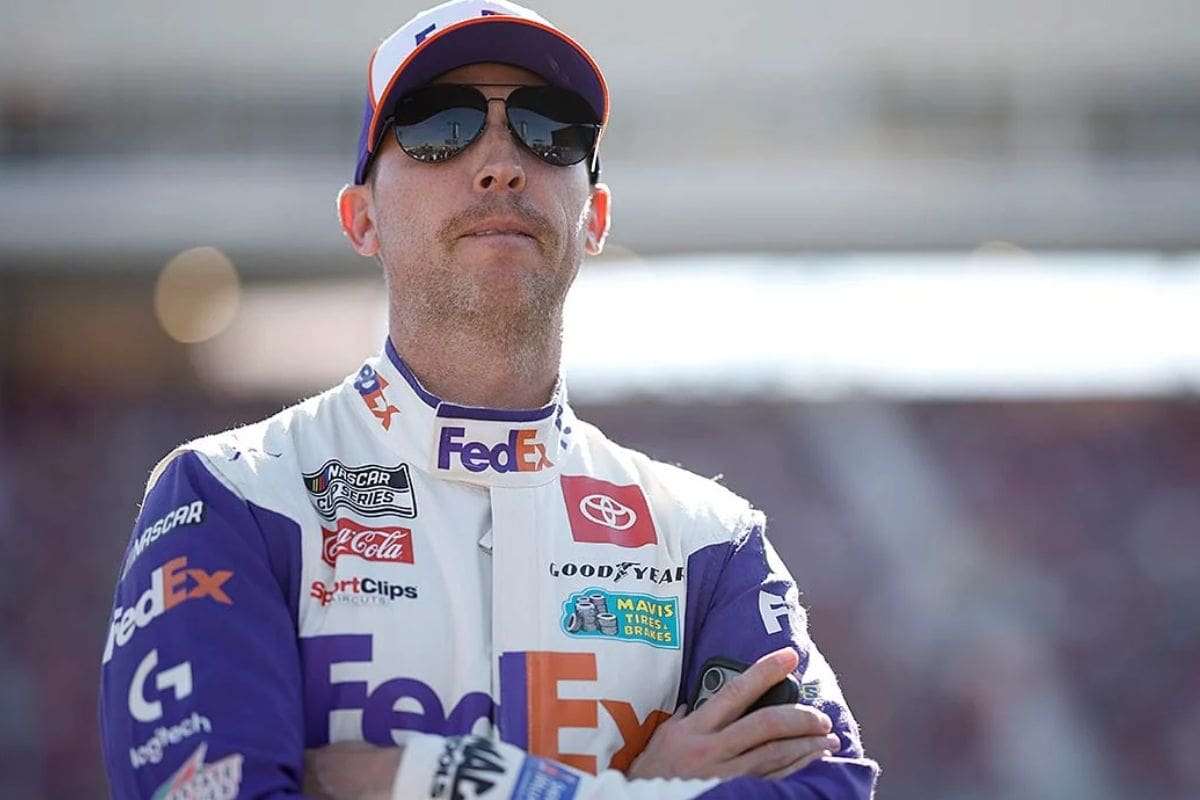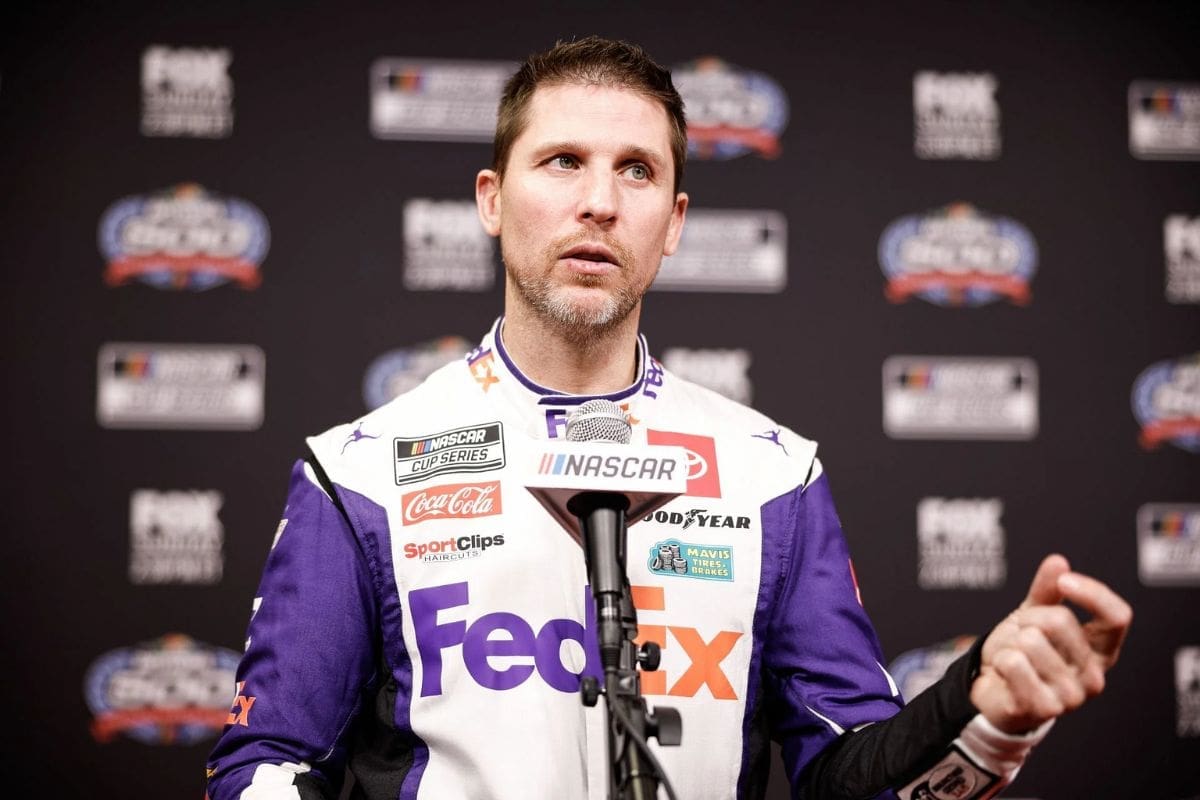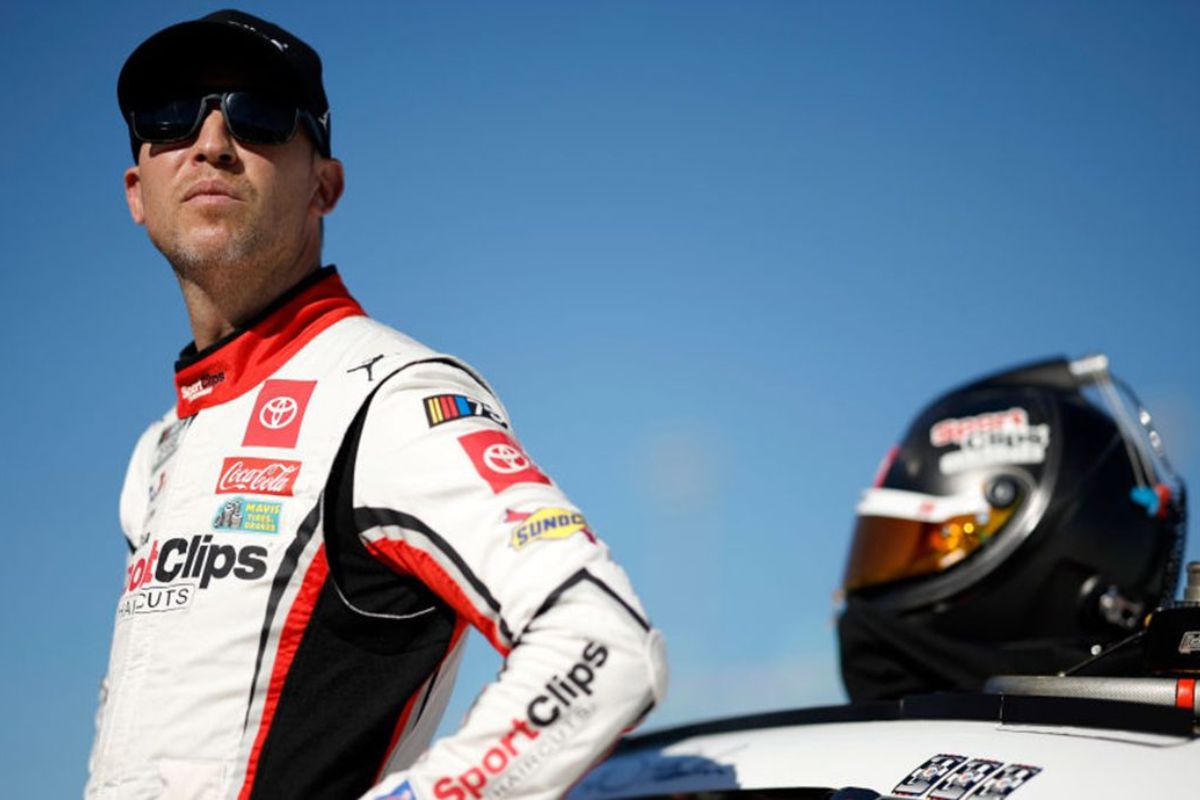Denny Hamlin on Two Tire Selection: In NASCAR, the recent session at the track left drivers and fans alike buzzing with excitement and anticipation. Among those offering valuable insights into the dynamics of the competition was Denny Hamlin, a seasoned veteran renowned for his expertise on the track. Emphasizing the critical role of tire selection in shaping race strategy, Hamlin highlighted the performance disparity between different tire options and its impact on lap times and passing opportunities. As fans took to social media to share their reactions to Hamlin’s comments, a diverse range of responses emerged.
Hamlin is Happy
Denny Hamlin provided valuable insights into the dynamics of the competition. Emphasizing the significance of tire selection, Hamlin highlighted the performance disparity between the two tire options, praising the tire’s contribution to lap time variation and its impact on race strategy. With drivers navigating the track with precision and skill, the ability to pass became a crucial aspect of the race, as differing speeds among cars added an element of unpredictability to the competition.
“It’s just a great tire. Great lap time variation between the two tires and also just the ability to pass with it because there’s a difference in speed between the cars. So as you’re seeing now, guys are searching for new payment to try to get grip because they don’t want to be in the rubber because it is kind of slick. So really, really fun right now. This is like back to the old short track game. “-denny hamlin
This sure seems encouraging! Let's hope it keeps playing out this way. https://t.co/tNX89HYnw3
— Jeff Gluck (@jeff_gluck) May 17, 2024
Hamlin’s observations shed light on the strategics undertaken by drivers, as they searched for new path to gain traction and maintain control on the slick rubber-coated surface. The quest for grip became a paramount concern for competitors, prompting them to explore alternative racing lines and adapt their driving techniques to the challenging conditions. As Hamlin noted, the current environment harkened back to the essence of short track racing, where drivers relied on instinct, finesse, and sheer determination to navigate the track and outmaneuver their rivals.
Fan Reactions on Denny’s Comments
Following Denny Hamlin’s insightful remarks about the qualifying session, fans took to social media to express their reactions, ranging from enthusiastic agreement to playful banter. One fan echoed Hamlin’s sentiment applauding the focus on tire performance and the return to traditional racing dynamics.
“This is what short tracks need.”
“Can’t argue with Denny here, even as someone that enjoys booing him from time to time.” – fans reaction
Amidst the mix of reactions, a nod to Hamlin’s surname sparked a humorous exchange among fans. Eliciting laughter and further engagement from fellow users. Such playful banter adds a touch of levity to the discourse, highlighting the sense of community and shared passion within the fanbase.
Denny is named after America’s greatest chain,“
“Why do we always hear from him!?!? Aren’t there any other drivers with a valid opinion!?!?” – fans reaction
However, not all responses were light-hearted, as some questioned the prominence of Hamlin’s voice in the discussion. A fan, expressing a desire for diverse perspectives and insights from a range of drivers.
“Why do we always hear from him!?!? Aren’t there any other drivers with a valid opinion!?!?” – fan reaction
Ultimately, amidst the diversity of opinions and humorous exchanges, one consensus emerged: Goodyear’s tire selection had struck a chord with fans and drivers alike.
“Goodyear nailed it with this tire. I think we found the short track solution boys.” – fan reaction
This encapsulating the prevailing sentiment of optimism and excitement surrounding the potential impact of the tire on future races. As fans eagerly anticipate the upcoming events, the buzz of anticipation and camaraderie continues to thrive within the NASCAR community, uniting fans in their shared love for the sport.
The Short Track Problem
Short tracks in NASCAR present a unique set of challenges that demand both skill and adaptability from drivers. Denny Hamlin’s recent successes at venues like Dover, Bristol, and Richmond shows his prowess on these tight, demanding circuits. However, his victories also shed light on the complexities inherent in short track racing.
One of the key issues facing short tracks is the need for innovative solutions to enhance competitiveness while maintaining the integrity of the racing experience. Ryan Blaney’s call for NASCAR to revamp the short-track package highlights the urgency of addressing these challenges. His specific suggestions, such as modifying ride height, underscore the nuanced nature of the changes needed to improve racing dynamics.
Implementing such alterations, however, is no simple task. Adjusting the ride height of Next-Gen cars requires a delicate balance between various factors, including aerodynamics, tire wear, and safety considerations. Any changes made must be carefully evaluated to ensure they enhance the quality of racing without compromising other aspects of performance or safety.
Moreover, the discussion surrounding short tracks extends beyond technical adjustments to encompass broader considerations of track layout, fan experience, and the overall direction of the sport. Finding the right balance between tradition and innovation is essential in addressing the challenges faced by short tracks and ensuring their continued relevance in NASCAR’s future.
In navigating these complexities, collaboration between drivers, teams, track officials, and NASCAR leadership is paramount. By fostering open dialogue and leveraging collective expertise, the sport can work towards implementing solutions that benefit all stakeholders and preserve the essence of short track racing while adapting to the demands of the modern era.
Probable Solutions for Short-Tracks
Addressing the challenges faced by short tracks in NASCAR requires a multifaceted approach that considers various potential solutions. One of the most straightforward proposals, often advocated by drivers like Denny Hamlin, is a significant increase in horsepower. By boosting engine power to levels reminiscent of the early and mid-2010s, drivers hope to make the cars more demanding to drive on shorter tracks, adding an element of excitement and skill to the racing.
However, NASCAR Executive Vice President Steve O’Donnell emphasizes that while increasing horsepower is an option under consideration, the decision-making process is complex. Factors such as cost, manufacturer involvement, and technological considerations must be carefully weighed. Any changes made must align with the interests of Original Equipment Manufacturers (OEMs) and be compatible with potential new technologies, ensuring a sustainable and forward-thinking approach to the sport’s evolution.
In addition to horsepower increases, NASCAR is exploring short-term solutions aimed at improving the racing experience on short tracks. One such proposal involves modifying gear ratios to reduce the need for shifting, thereby streamlining the driving experience and potentially increasing the competitiveness of races. Additionally, changes in underbody designs are being considered to decrease downforce, promoting closer racing and more opportunities for overtaking.
These adjustments represent proactive steps towards enhancing the competitiveness and excitement of short track racing in NASCAR. By considering a range of solutions, from horsepower increases to gear ratio modifications and underbody design changes, the sport aims to strike a balance between tradition and innovation while delivering thrilling racing for fans and drivers alike.
NEWS in Brief: Denny Hamlin on Two Tire Selection
The recent qualifying session at the track, coupled with Denny Hamlin’s insightful remarks and the vibrant fan reactions that followed, encapsulates the essence of NASCAR’s enduring appeal. As drivers navigate the challenges of the slick rubber-coated surface and strategize to gain an edge on the competition, fans eagerly anticipate the exhilarating battles that lie ahead. From enthusiastic agreement to playful banter and spirited discourse, the NASCAR community remains united by its shared love for the sport.
As the sport continues to evolve, fueled by the passion of its devoted fanbase, one thing remains certain: the excitement and anticipation surrounding NASCAR are as vibrant as ever, promising a future filled with unforgettable moments on and off the track.
Our Reader’s Queries
Q. What was the NASCAR decision on Denny Hamlin?
A. Sawyer confirmed on Tuesday that there was indeed an early roll by Hamlin preceding the final restart. Despite this observation, NASCAR opted not to impose a penalty following a review of the restart. Ultimately, Hamlin emerged victorious in the race. The enduring success of the Cup team and the unique connection with Martinsville Speedway underscore a special and longstanding bond between the two entities.
Q. Has Denny Hamlin ever won on a road course?
A. In a pivotal moment, Hamlin clinched his inaugural road course triumph by commanding the lead for just 10 laps out of the 90-lap race – notably, during the crucial closing stages. This victory served as redemption for Hamlin, who had come agonizingly close to victory at Sonoma Raceway earlier in the season. A slight misstep on the final lap had opened the door for Tony Stewart to snatch the win, making this triumph all the more gratifying for Hamlin.
Q. How many races has Denny Hamlin won in 2024?
A. Just a week ago, Hamlin secured his third victory of 2024 at Dover Motor Speedway. Impressively, this win came shortly after he confidently predicted success on his podcast, “Actions Detrimental.”
ALSO READ: Denny Hamlin Targets Historic Feat: Matching Stewart, Keselowski

